Lung cancer - small cell
Small cell lung cancer (SCLC) is a fast-growing type of lung cancer. It spreads much more quickly than non-small cell lung cancer.
Lung cancer
Lung cancer is cancer that starts in the lungs. The lungs are located in the chest. When you breathe, air goes through your nose, down your windpipe...

Non-small cell lung cancer
Non-small cell lung cancer is the most common type of lung cancer. It usually grows and spreads more slowly than small cell lung cancer. There are t...

Lung cancer - Animation
Cancer can affect just about any part of the body, from the colon to the pancreas. Some cancers grow quickly, while others grow more slowly and are easier to treat. But of all the different cancers out there, one of the deadliest is lung cancer. Let's talk today about lung cancer. Cancer starts when cells begin to grow uncontrollably and form tumors. In the case of lung cancer, the tumors start in the lungs. Sometimes cancer starts somewhere else in the body and then spreads to the lungs. In that case, it's called metastatic cancer to the lung. Metastatic means disease that has spread. There are two types of lung cancer. The most common, and slower-growing form is non-small cell lung cancer. The other, faster-growing form is called small cell lung cancer. The most common way to get lung cancer is to smoke cigarettes. The more cigarettes you smoke and the earlier you start smoking, the greater your risk is. Even being around someone who smokes and breathing in the secondhand smoke from their cigarettes increases your risk of getting lung cancer. Even though smoking makes you much more likely to get lung cancer, you don't have to smoke or be exposed to smoke to get the disease. Some people who have lung cancer never lit up a cigarette in their life. They have been exposed to cancer-causing substances like asbestos, diesel fumes, arsenic, radiation, or radon gas. Or, they may not have had any known lung cancer risks. The most common signs of lung cancer are a cough that won't go away, chest pain, shortness of breath, weight loss, and fatigue. But just because you have these symptoms it doesn't mean that you have don't have lung cancer. These can also be signs of other conditions, like asthma or a respiratory infection. If you do have these symptoms, see your doctor. A chest x-ray, MRI, or CT scan can view the inside of your lungs to look for signs of cancer or other diseases. What happens if you do have lung cancer? Doctors divide lung cancer into stages. The higher the stage, the more the cancer has spread. For example, a stage 1 cancer is small and hasn't spread outside of the lungs. A stage 4 cancer has spread to the other organs, such as the kidneys or brain. Depending upon the type and stage of your lung cancer, you may need surgery to remove part or all of your lung. Or, your doctor may recommend radiation or chemotherapy to kill cancer cells. If you have lung cancer, how well you do depends upon the stage of your disease and the type of lung cancer that you have. Early-stage cancers have the highest survival and cure rates. Late-stage cancers are harder to treat. Because lung cancer can be so deadly, prevention is key. The most important that thing you can do is to stop smoking, and avoid being around anyone who does smoke.
There are two types of SCLC:
- Small cell carcinoma (oat cell cancer)
- Combined small cell carcinoma
Most SCLCs are of the oat cell type.
Causes
About 15% of all lung cancer cases are SCLC. Small cell lung cancer is slightly more common in men than women.
Almost all cases of SCLC are due to cigarette smoking. SCLC is very rare in people who have never smoked.
SCLC is the most aggressive form of lung cancer. It usually starts in the breathing tubes (bronchi) in the center of the chest. Although the cancer cells are small, they grow very quickly and create large tumors. These tumors often spread rapidly (metastasize) to other parts of the body, including the brain, liver, and bone.
Symptoms
Symptoms of SCLC include:
- Bloody sputum (phlegm)
Bloody sputum
Coughing up blood is the spitting up of blood or bloody mucus from the lungs and throat (respiratory tract). Hemoptysis is the medical term for cough...
 ImageRead Article Now Book Mark Article
ImageRead Article Now Book Mark Article - Chest pain
Chest pain
Chest pain is discomfort or pain that you feel anywhere along the front of your body between your neck and upper abdomen.
 ImageRead Article Now Book Mark Article
ImageRead Article Now Book Mark Article - Cough
- Loss of appetite
- Shortness of breath
Shortness of breath
Breathing difficulty may involve:Difficult breathing Uncomfortable breathingFeeling like you are not getting enough air
 ImageRead Article Now Book Mark Article
ImageRead Article Now Book Mark Article - Weight loss
Weight loss
Unexplained weight loss is a decrease in body weight, when you did not try to lose the weight on your own. Many people gain and lose weight. Uninten...
Read Article Now Book Mark Article - Wheezing
Other symptoms that may occur with this disease, especially in the late stages, include:
- Facial swelling
Facial swelling
Facial swelling is the buildup of fluid in the tissues of the face. Swelling may also affect the neck and upper arms.
 ImageRead Article Now Book Mark Article
ImageRead Article Now Book Mark Article - Fever
- Hoarseness or changing voice
Hoarseness or changing voice
Hoarseness refers to difficulty making sounds when trying to speak. Vocal sounds may be weak, breathy, scratchy, or husky, and the pitch or quality ...
 ImageRead Article Now Book Mark Article
ImageRead Article Now Book Mark Article - Swallowing difficulty
- Weakness
Exams and Tests
Your health care provider will perform a physical exam and ask about your medical history. You will be asked whether you smoke, and if so, how much and for how long.
When listening to your chest with a stethoscope, your provider may hear fluid around the lungs or areas where the lung has partially collapsed. Each of these findings may suggest cancer.
Collapsed
A collapsed lung occurs when air escapes from the lung. The air then fills the space outside of the lung between the lung and chest wall. This buil...

SCLC has usually spread to other parts of your body by the time it is diagnosed.
Tests that may be performed include:
- Bone scan
Bone scan
A bone scan is an imaging test used to diagnose bone diseases and find out how severe they are.
 ImageRead Article Now Book Mark Article
ImageRead Article Now Book Mark Article - Chest x-ray
- Complete blood count (CBC)
CBC
A complete blood count (CBC) test measures the following:The number of white blood cells (WBC count)The number of red blood cells (RBC count)The numb...
 ImageRead Article Now Book Mark Article
ImageRead Article Now Book Mark Article - CT scan
CT scan
A chest CT (computed tomography) scan is an imaging method that uses x-rays to create cross-sectional pictures of the chest and upper abdomen....
 ImageRead Article Now Book Mark Article
ImageRead Article Now Book Mark Article - Liver function tests
Liver function tests
Liver function tests are common tests that are used to see how well the liver is working. Tests include:AlbuminAlpha-1 antitrypsinAlkaline phosphata...
 ImageRead Article Now Book Mark Article
ImageRead Article Now Book Mark Article - MRI scan
MRI scan
A chest MRI (magnetic resonance imaging) scan is an imaging test that uses powerful magnetic fields and radio waves to create pictures of the chest (...
 ImageRead Article Now Book Mark Article
ImageRead Article Now Book Mark Article - Positron emission tomography (PET) scan
PET
A lung positron emission tomography (PET) scan is an imaging test. It uses a radioactive substance (called a tracer) to look for disease in the lung...
 ImageRead Article Now Book Mark Article
ImageRead Article Now Book Mark Article - Sputum test (to look for cancer cells)
Sputum test
Routine sputum culture is a laboratory test that looks for germs that cause infection. Sputum is the material that comes up from air passages when y...
 ImageRead Article Now Book Mark Article
ImageRead Article Now Book Mark Article - Thoracentesis (removal of fluid from the chest cavity around the lungs)
Thoracentesis
Thoracentesis is a procedure to remove fluid from the space between the lining of the outside of the lungs (pleura) and the wall of the chest....
Read Article Now Book Mark Article
In most cases, a piece of tissue is removed from your lungs or other areas to be examined under a microscope. This is called a biopsy. There are several ways to do a biopsy:
- Bronchoscopy combined with biopsy
Bronchoscopy
Bronchoscopy is a test to view the airways and diagnose lung disease. It may also be used during the treatment of some lung conditions.
 ImageRead Article Now Book Mark Article
ImageRead Article Now Book Mark ArticleBiopsy
A biopsy is the removal of a small piece of tissue for lab examination.
 ImageRead Article Now Book Mark Article
ImageRead Article Now Book Mark Article - CT scan-directed needle biopsy
CT scan-directed needle biopsy
A lung needle biopsy is a method to remove a piece of lung tissue for examination. If it is done through the wall of your chest, it is called a tran...
 ImageRead Article Now Book Mark Article
ImageRead Article Now Book Mark Article - Endoscopic esophageal or bronchial ultrasound with biopsy
- Mediastinoscopy with biopsy
Mediastinoscopy with biopsy
Mediastinoscopy with biopsy is a procedure in which a lighted instrument (mediastinoscope) is inserted in the space in the chest between the lungs (m...
 ImageRead Article Now Book Mark Article
ImageRead Article Now Book Mark Article - Open lung biopsy
Open lung biopsy
An open lung biopsy is surgery to remove a small piece of tissue from the lung. The sample is then examined for cancer, infection, or lung disease....
 ImageRead Article Now Book Mark Article
ImageRead Article Now Book Mark Article - Pleural biopsy
Pleural biopsy
Pleural biopsy is a procedure to remove a sample of the pleura. This is the thin tissue that lines the chest cavity and surrounds the lungs. The bi...
 ImageRead Article Now Book Mark Article
ImageRead Article Now Book Mark Article - Video-assisted thoracoscopy
Video-assisted thoracoscopy
Lung surgery is surgery done to repair or remove lung tissue. There are many common lung surgeries, including:Biopsy of an unknown growth in or arou...
 ImageRead Article Now Book Mark Article
ImageRead Article Now Book Mark Article
Usually, if a biopsy shows cancer, more imaging tests are done to find out the stage of the cancer. Stage means how big the tumor is and how far it has spread. SCLC is classified as either:
- Limited -- Cancer is only in the chest and can be treated with radiation therapy.
- Extensive -- Cancer has spread outside the area that can be covered by radiation therapy.
Treatment
Because SCLC spreads quickly throughout the body, treatment will include cancer-killing drugs (chemotherapy), which are usually given through a vein (by IV).
Chemotherapy
The term chemotherapy is used to describe cancer-killing drugs. Chemotherapy may be used to:Cure the cancerShrink the cancerPrevent the cancer from ...

Treatment with chemotherapy and immunotherapy, and possibly radiation, may be done for people with SCLC that has spread throughout the body (extensive). In this case, the treatment only helps relieve symptoms and prolongs life, but does not cure the disease.
Radiation
Radiation therapy uses high-powered radiation (such as x-rays or gamma rays), particles, or radioactive seeds to kill cancer cells.

Radiation therapy can be used with chemotherapy if the disease is confined to one area within the chest (limited).
Radiation therapy uses powerful x-rays or other forms of radiation to kill cancer cells.
Radiation may be used to:
- Treat the cancer, along with chemotherapy, if surgery is not possible.
- Help relieve symptoms caused by the cancer, such as breathing problems and swelling.
- Help relieve cancer pain when the cancer has spread to the bones.
Often, SCLC may have already spread to the brain. This can occur even when there are no symptoms or other signs of cancer in the brain. As a result, some people with smaller cancers, or who had a good response in their first round of chemotherapy, may receive radiation therapy to the brain. This therapy is done to prevent spread of the cancer to the brain.
Surgery helps very few people with SCLC because the disease has often spread by the time it is diagnosed. Surgery may be done when there is only one tumor that has not spread. If surgery is done, chemotherapy or radiation therapy is still needed.
Support Groups
You can ease the stress of illness by joining a cancer support group. Sharing with others who have common experiences and problems can help you not feel alone.
Cancer support group
The following organizations are good resources for information on cancer:American Cancer Society. Support and online communities. www. cancer. org/...
Read Article Now Book Mark ArticleOutlook (Prognosis)
How well you do depends on how much the lung cancer has spread. SCLC is very deadly. Not many people with this type of cancer are still alive 5 years after diagnosis.
Treatment can often prolong life to more than 12 months, even when the cancer has spread.
In rare cases, if SCLC is diagnosed early, treatment may result in a long-term cure.
When to Contact a Medical Professional
Contact your provider if you have symptoms of lung cancer, particularly if you smoke.
Prevention
If you smoke, now is the time to quit. If you are having trouble quitting, talk with your provider. There are many methods to help you quit, from support groups to prescription medicines. Also try to avoid secondhand smoke.
Support groups
It is hard to quit smoking if you are acting alone. Smokers usually have a much better chance of quitting with a support program. Stop smoking prog...

Prescription medicines
Nicotine replacement therapy is a treatment to help people stop smoking. It uses products that supply low doses of nicotine. These products do not ...

If you smoke or used to smoke, talk with your provider about getting screened for lung cancer. To get screened, you need to have a CT scan of the chest.
Reviewed By
Todd Gersten, MD, Hematology/Oncology, Florida Cancer Specialists & Research Institute, Wellington, FL. Review provided by VeriMed Healthcare Network. Also reviewed by David C. Dugdale, MD, Medical Director, Brenda Conaway, Editorial Director, and the A.D.A.M. Editorial team.
Araujo LH, Horn L, Merritt RE, Shilo K, Xu-Welliver M, Carbone DP. Cancer of the lung: non-small cell lung cancer and small cell lung cancer. In: Niederhuber JE, Armitage JO, Kastan MB, Doroshow JH, Tepper JE, eds. Abeloff's Clinical Oncology. 6th ed. Philadelphia, PA: Elsevier; 2020:chap 69.
National Comprehensive Cancer Network website. NCCN clinical practice guidelines in oncology: Small cell lung cancer. Version 1.2024. www.nccn.org/professionals/physician_gls/pdf/sclc.pdf. Updated September 5, 2023. Accessed September 28, 2023.
National Cancer Institute website. Small cell lung cancer treatment (PDQ) - health professional version. www.cancer.gov/types/lung/hp/small-cell-lung-treatment-pdq. Updated March 2, 2023. Accessed September 8, 2023.
Rivera MP, Mody GN, Weiner AA. Lung cancer: treatment. In: Broaddus VC, Ernst JD, Talmadge EK, et al, eds. Murray and Nadel's Textbook of Respiratory Medicine. 7th ed. Philadelphia, PA: Elsevier; 2022:chap 77.

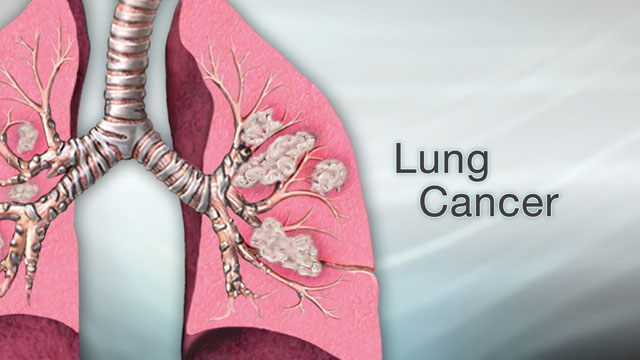
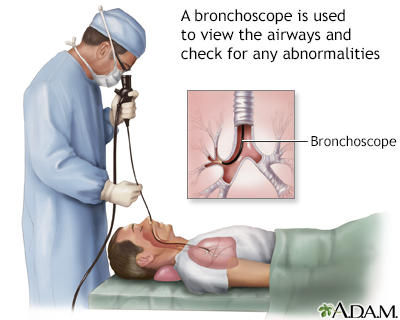







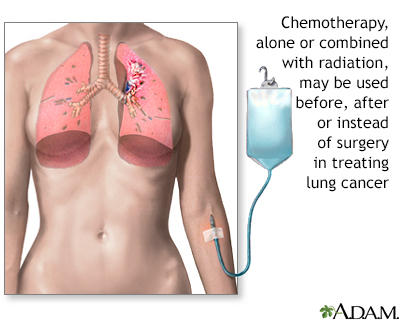
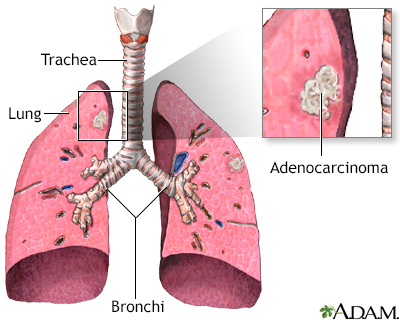
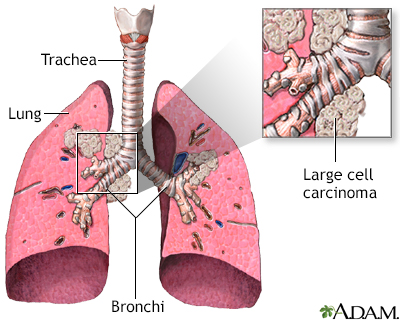
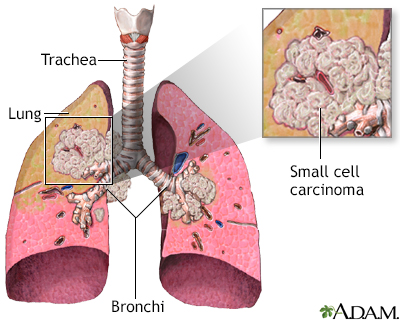
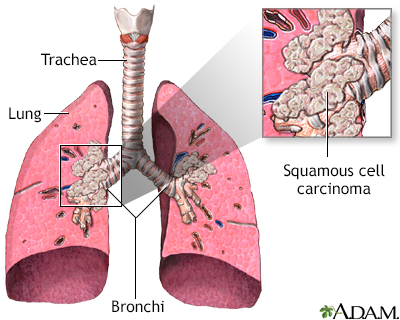
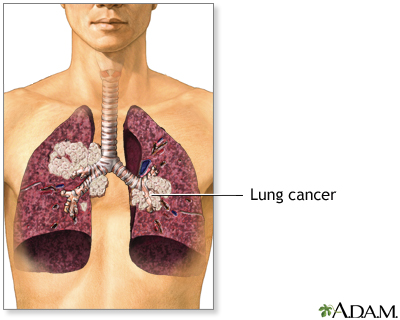
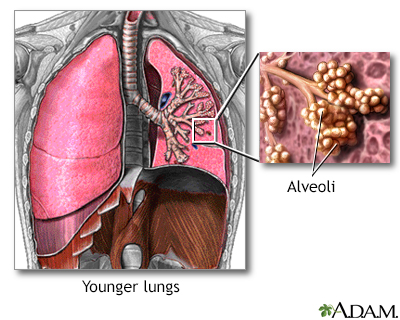

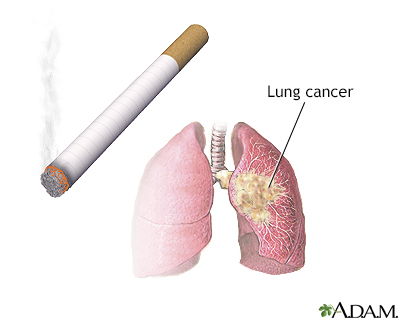
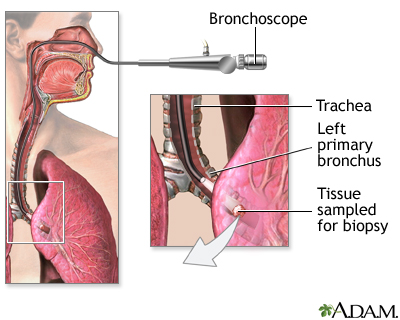
 All rights reserved.
All rights reserved.